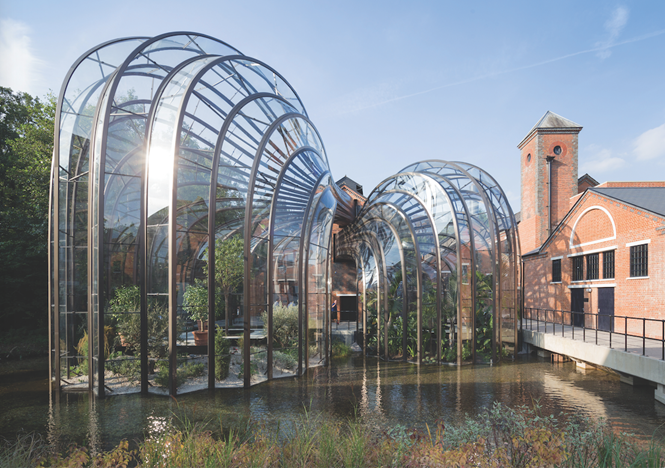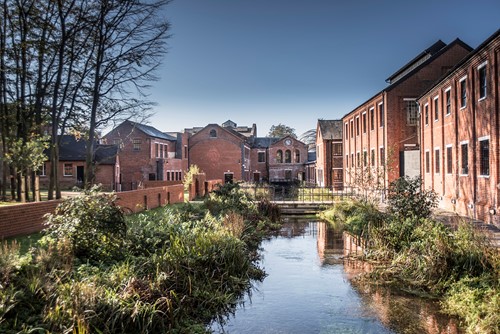Green houses for Sapphire distillery

From Cuba to Hampshire, Bacardí has taken its environmental responsibility global. Its gin production process, based in England, is part of a strategic approach to design that reduces the company’s environmental impact. Hassan Butt reports on the sustainability strategy
Over 150 years have passed since Don Facundo Bacardí Massó glanced up at the rafters of his modest distillery to find a colony of fruit bats comfortably nested in its eaves. Along the way, the Cuban enterprise has won more than 550 awards, hosted Nobel Prize parties for Ernest Hemingway and stood firm against Fidel Castro and the Cuban Revolution. Yet despite the beloved bat symbol remaining largely unchanged, Facundo Bacardí’s penchant for preservation soon made way for innovation, a lasting quality that has solidified Bacardí as the largest privately held, family-owned spirit company in the world.
With a portfolio of over 200 brands, Bacardí’s tradition for sustainability has long been a part of its brand story. Aligning itself with the Spanish government of Cuba’s mandate to reduce surplus molasses, Facundo Bacardí traditionally repurposed old whisky barrels to age his famous rum, revolutionising the sugarcane sector. Likewise, across Bacardí’s growing brand portfolio, collective sustainability efforts translate to exemplary standards in renewable energy use, water usage and packaging, as well as a conscious effort to promote local wildlife.
Yet in understanding how sustainability forms part of the company strategy today, Bacardí’s most established gin brand, Bombay Sapphire, serves as its most innovative example of sustainable production to date. Launched in 1987 by the now-defunct wine and spirits distribution company, International Distillers & Vintners (IDV), Bombay Sapphire was briefly under the care of British multinational company, Diageo, before being sold to Bacardí Limited in 1997.
The worldwide production of gin however, is a challenging process. Its distillation is one of the most meticulous, its flavour infusion one of the most sophisticated and its composition comprehensive. However, since the development of the column still in the early 1800s, largescale production of spirits has ballooned, and with it so too have the dangers of environmental damage.
In 2011, Bacardí Limited unveiled plans to move production of Bombay Sapphire to Laverstoke Mill, an old paper mill that sits within a conservation area in Hampshire, southern England. Known formerly for printing bank-notes, the mill’s heritage dates back to 903 AD, with records showing its usage as a corn mill in 1086. In the early 18th century, Henry Portal converted the mill for printing purposes. The new distillery was subject to a thorough renovation initiative before opening its doors in 2014 and revitalising three grade II listed buildings with sustainability as a driving force.
Julio Toruella, global environment director – operations at Bacardí Limited, says, “Sustainability was a major factor in picking the right place as a site for Bombay Sapphire, through both the production process, and finding a place to retrofit and renovate, as opposed to building something from scratch.”
“Sustainability was a major factor in picking the right site for Bombay Sapphire, through both the production process, and finding a place to retrofit and renovate, as opposed to building something from scratch”
Steering the transformation, Bacardí consulted Heatherwick Studio, directed by renowned British designer, Thomas Heatherwick, whose previous projects include the revamp of London’s Routemaster bus, the 2012 Olympic cauldron and Manchester’s former landmark sculpture, B of the Bang. Yet aligning Bombay Sapphire’s secret recipe, established in 1761, its in-depth production procedure and Bacardí Limited’s ongoing pledge towards sustainable production, proved an initial challenge for the development of Laverstoke Mill.
Overcoming this, Heatherwick designed two curved glasshouses for the botanicals used in Bombay Sapphire’s vapour distillation process. The first holds a humid tropical climate, the second, a temperate Mediterranean. “Heatherwick described the site as ‘suffocated with buildings.’ There were temporary buildings and general debris left by various contracted companies. The river Test, which flows through the site, was entirely boarded up. Heatherwick used the river as a navigational tool to lead the design of the site,” says Toruella.
Through Heatherwick’s innovative design, the banks of the river Test were widened and reshaped with planted foreshores. Wasted heat and materials from the distillation process are now recycled into the greenhouses and riverbed to maintain its unique formation. Yet central to Bacardí’s brand strategy throughout Laverstoke Mill’s sustainable renovation, is customer integration. Today the site holds
a visitor’s centre, and its construction allows for visitor interaction. Proximity to the distillation process is maintained through intertwining walkways across the collection of buildings, allowing guests to be part of the Bombay Sapphire journey.
For Bacardí, however, projects such as Laverstoke Mill not only illustrate the company’s creative agenda on functioning sustainably, it holds authenticity, quality and creativity in the same breath. Heatherwick Studio worked closely with a team from the Royal Botanic Gardens at Kew on developing the horticultural ecosystem present onsite. Following the completion of Laverstoke Mill, the project won the 2014 Building Research Establishment Environmental Assessment Methodology (BREEAM) Industrial Award, an accolade that signifies the projects efforts in sustainable best practice.
Bacardí Limited’s Laverstoke Mill and Bombay Sapphire production process are merely examples of the wider standard upheld across the company with regards to environmental responsibility. Its awareness of the company’s environmental impact is unique in the food and beverage sector. Equally in 2014, Bacardí introduced its own sustainability metric system known as Bacardí Environmental Sustainability Tracking (BEST), measuring annual performance and progress in ensuring its sustainability objectives are met. As Bacardí’s environmentally focused initiatives shine through in further work such as underwater wildlife preservation and slicing its carbon footprint across the entire fold of its 29 facilities, Laverstoke Mill remains one of its most considered.
Bacardí’s unified approach to sustainability includes an organisational self-awareness of the brand name on one hand, and its product quality on the other. Yet primarily, Bacardí’s sustainability outlook forms the body of the organisation’s progressiveness. The challenge going forward, is whether its initiatives can continue to break the mould of the industry challenges with regards to sustainability.












